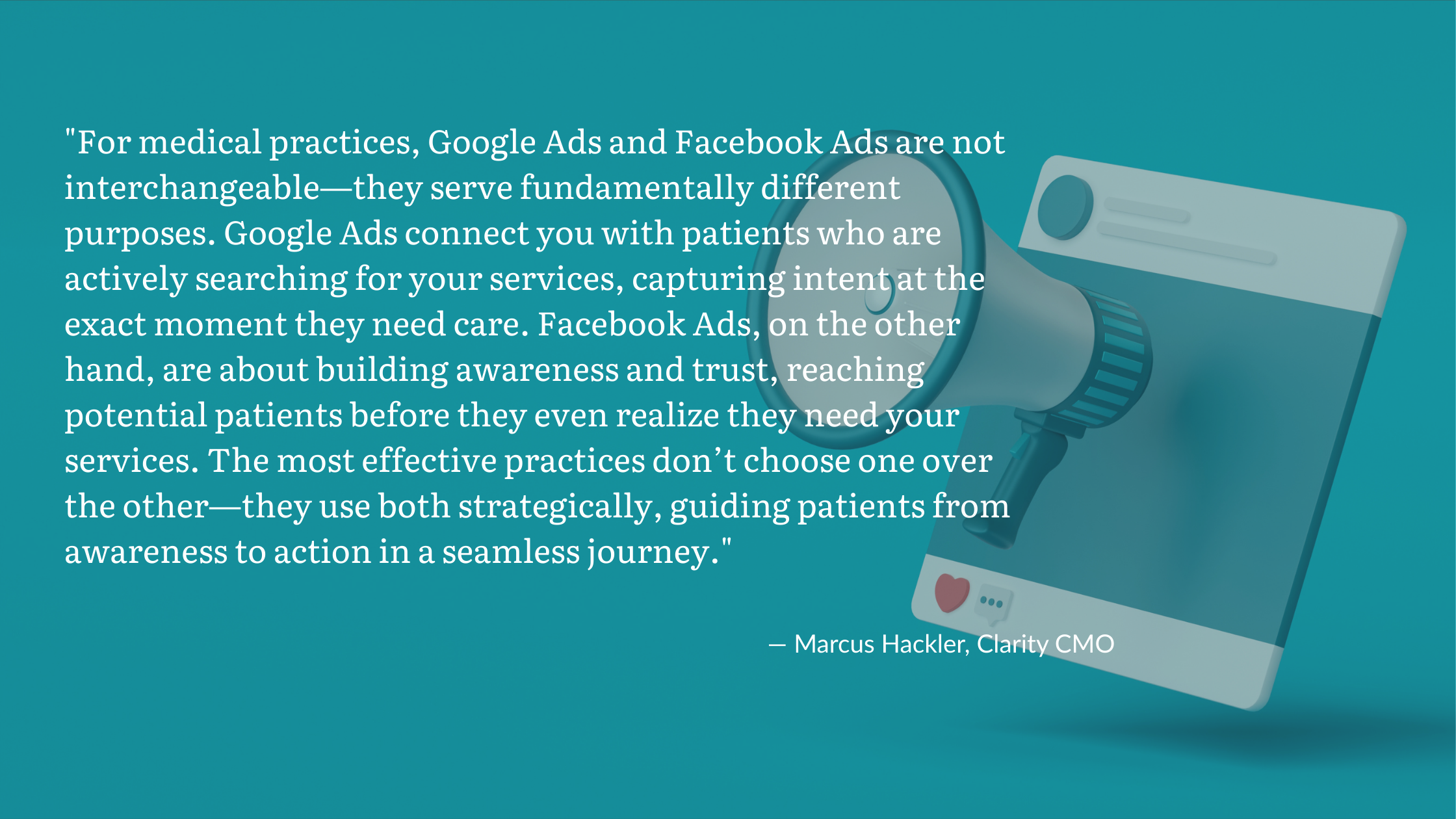Google Ads vs. Meta Ads: What Works Best for Medical Practices?
Oct 10, 2025 7:00:00 AM • Written by: Marcus Hackler

When it comes to digital advertising, medical practices face a critical question: Where should we invest — Google Ads or Meta Ads?
Both platforms can deliver results, but they work in fundamentally different ways. To make the right decision, it’s important to go beyond surface-level pros and cons and understand how patient psychology, the patient journey, and platform mechanics intersect.
Google Ads: Meeting Patients at the Point of Need
Google Ads are powerful because they capture patient intent. When someone types “plastic surgeon near me” or “hearing test appointment” or "LASIK doctor" they’re signaling urgency.
But here’s the nuance:
-
Search Volume Matters. If your specialty is highly searched (e.g., dentistry, dermatology, optometry, plastic surgery), Google Ads can deliver immediate leads. But for niche or elective services (e.g., advanced aesthetics, concierge medicine), search volume may be too limited to scale growth on Google alone.
-
Competition Affects Costs. In healthcare, especially urban markets, cost-per-click can skyrocket due to heavy competition. Practices need to evaluate whether the potential patient lifetime value offsets rising acquisition costs.
-
Trust Isn’t Instant. Even if your ad gets the click, a poorly designed landing page or lack of online reputation (reviews, testimonials) can undo the value of the ad spend. Google Ads open the door, but conversion depends on the credibility of what patients see next.
Google Ads are strongest when you want to capture patients who are actively looking right now, but success hinges on pairing ads with conversion-friendly websites and strong local reputation signals.
Meta Ads: Creating Awareness and Shaping Demand
Unlike Google, Meta Ads (Facebook & Instagram) don’t wait for patients to search — they place your message in front of them. This makes them more about demand creation than demand capture.
Here’s what’s often overlooked:
-
Patients Don’t Always Know What to Search. Someone considering Botox may not search “Botox near me” immediately. They may start with questions like “How to look less tired”. Meta Ads let you educate and influence patients before they ever think to Google it.
-
Attention Is Earned, Not Given. A sterile ad won’t stop the scroll. Practices that succeed on Meta lean into storytelling — showcasing patient transformations, behind-the-scenes looks, or authentic provider insights. Ads that feel like content (not commercials) perform best.
-
Retargeting Closes the Loop. Meta’s ability to retarget website visitors or people who engaged with your content is invaluable. Many practices miss this step, but it’s often the difference between ads that “raise awareness” and ads that actually generate appointments.
Meta Ads are best for specialties that require patient education, emotional buy-in, or visual proof — aesthetics, cosmetic dentistry, audiology, and ophthalmology are strong fits.
Where Practices Go Wrong
Most practices choose a platform based on budget rather than strategy. That’s where problems arise.
-
Relying solely on Google Ads risks plateauing growth if search demand in your area is already saturated.
-
Relying solely on Meta Ads risks building awareness without conversion, leaving staff frustrated when “all those likes” don’t turn into appointments.
The key is alignment: understanding the role each platform plays in the patient journey.

The Smartest Approach: A Dual Funnel
The most successful practices blend Google and Meta strategically:
-
Meta Ads introduce your brand, educate patients, and build trust.
-
Google Ads capture them when they’re ready to act.
Think of it like planting and harvesting. Meta plants the seeds of interest and trust. Google reaps the results when patients decide to take action.
For example:
-
A LASIK clinic might use Meta to run explainer videos about the procedure and patient testimonials. Months later, when those same patients finally Google “LASIK near me”, the clinic’s ad appears — and they already have a sense of familiarity and trust.
Measuring What Really Matters
Here’s where practices often miss the mark: success isn’t just about clicks or impressions. It’s about operational outcomes.
-
Did your front desk convert the calls generated by Google Ads?
-
Did your staff follow up on Meta leads quickly, or did they go cold?
-
Are you tracking which ad patients mention when booking, or relying only on what the software shows?
Without operational alignment, no ad strategy will feel like it “works.”
Final Thoughts
The debate isn’t Google Ads vs. Meta Ads. It’s how to use them together, strategically, to guide patients from curiosity to commitment.
For medical practices, this means:
-
Using Google Ads to meet immediate demand.
-
Using Meta Ads to shape perceptions, educate patients, and nurture trust.
-
Investing in front-desk training and follow-up systems to ensure that leads don’t just come in — they convert.
If you've never dipped your toe into the digital advertising world, we've got you covered. We've created a guide to getting started with Google Performance Max and Meta Ads you can download for free below. It contains effective, clickable headlines and ad copy for Google Ads, and Ad Recommendations for Meta that provide image descriptions as well as ad copy. All that we ask is you provide your contact information.
